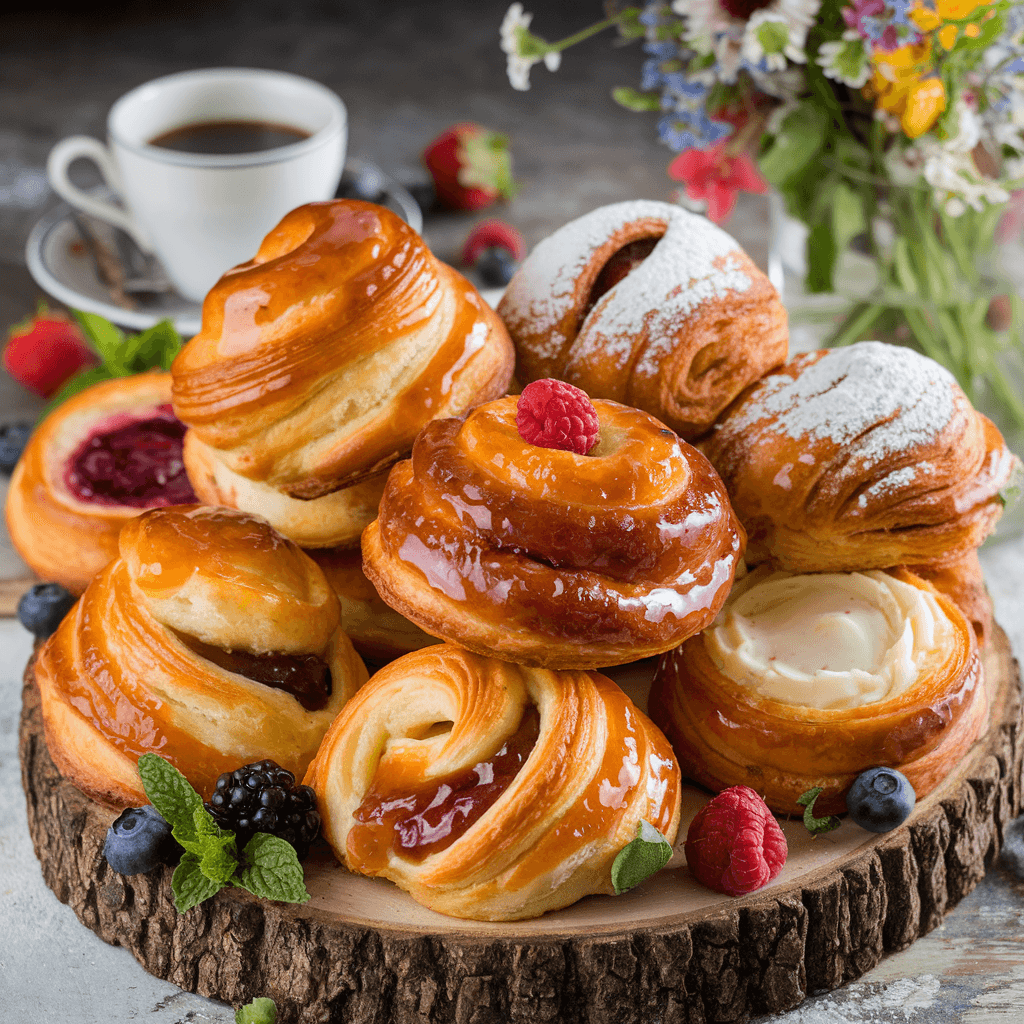Table of Contents
Introduction to Breakfast Pastries
What’s better than waking up to the aroma of freshly baked pastries? Breakfast pastries are more than just food—they’re tiny bundles of joy. Whether it’s a flaky croissant, a moist muffin, or a gooey cinnamon roll, pastries turn an ordinary morning into something magical.
But what exactly makes a pastry a “breakfast” pastry? Well, these treats are typically sweeter or savory baked goods enjoyed during the morning. They’re made with love, dough, and a sprinkle of imagination. Let’s dive deeper into this delicious world and explore what makes breakfast pastries so irresistible.
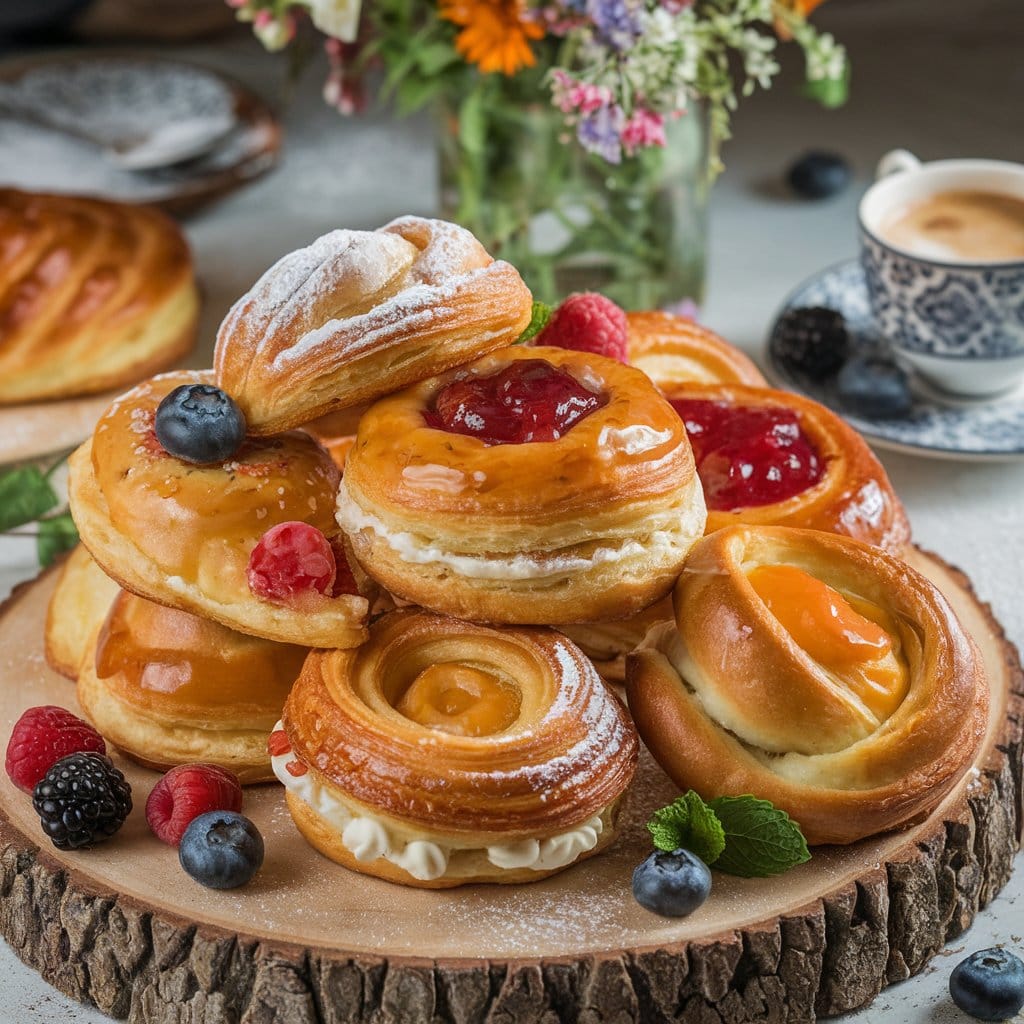
Types of Breakfast Pastries
Croissants: The French Favorite
Ah, the croissant! This buttery, flaky delight is synonymous with Parisian breakfasts. Its crescent shape and delicate layers make it iconic. But did you know croissants aren’t originally French? They were inspired by Austrian kipferl and refined into the masterpiece we love today.
Pro Tip: For the ultimate experience, pair your croissant with a cup of rich coffee or hot chocolate.
Danish Pastries: A Sweet Treat with a Twist
Danish pastries are like edible works of art. Originating in Denmark, these pastries are known for their fruit-filled centers and cream cheese toppings. They’re the perfect combination of sweet and creamy, making them a brunch table favorite.
Common Ingredients in Breakfast Pastries
Every great pastry begins with simple ingredients. Let’s break them down:
| Ingredient | Role in Pastries |
|---|---|
| Flour | Forms the structure of the pastry. |
| Butter | Adds richness and flakiness. |
| Sugar | Sweetens and caramelizes. |
| Eggs | Bind ingredients and add moisture. |
| Yeast (optional) | Helps pastries rise. |
If you’re health-conscious, there are plenty of substitutes! Almond flour works for gluten-free options, and coconut oil or vegan butter can replace traditional butter.
Recipe: Classic Blueberry Muffins
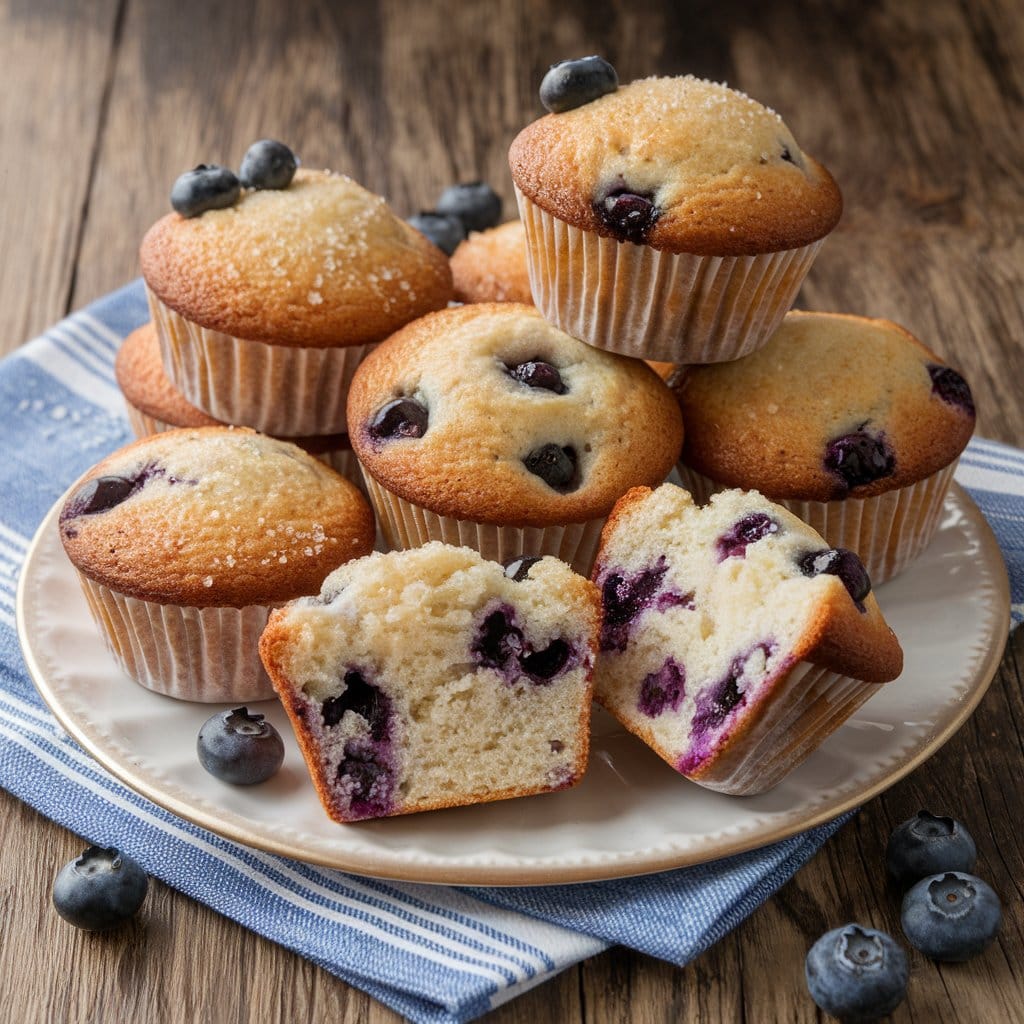
Ingredients:
- Flour: 2 cups
- Sugar: ¾ cup
- Baking Powder: 1 tablespoon
- Salt: ½ teaspoon
- Milk: 1 cup
- Eggs: 2
- Butter (melted): ½ cup
- Blueberries: 1 cup
Nutrition Facts (Per Serving):
| Nutrient | Amount |
|---|---|
| Calories | 210 |
| Protein | 5g |
| Fat | 9g |
| Carbs | 30g |
Steps to Make:
- Preheat and Prepare:
- Preheat your oven to 375°F (190°C).
- Grease a muffin tin or line it with paper liners to prevent sticking.
- Mix Dry Ingredients:
- In a large mixing bowl, combine flour, sugar, baking powder, and salt. Stir until evenly blended.
- Mix Wet Ingredients:
- In a separate bowl, whisk together milk, eggs, and melted butter until smooth.
- Combine Wet and Dry Ingredients:
- Gradually pour the wet mixture into the dry ingredients.
- Stir gently until just combined—don’t overmix, as this can make the muffins dense.
- Add Blueberries:
- Carefully fold in blueberries to evenly distribute them throughout the batter.
- Fill the Muffin Tin:
- Spoon the batter into the prepared muffin cups, filling each about 3/4 full.
- Bake:
- Place the muffin tin in the preheated oven and bake for 20-25 minutes, or until the tops are golden brown and a toothpick inserted in the center comes out clean.
- Cool and Serve:
- Let the muffins cool in the tin for about 5 minutes, then transfer them to a wire rack to cool completely.
- Serve warm or at room temperature. Perfect with a pat of butter or a drizzle of honey!
Pro Tip: For extra flavor, sprinkle a little sugar on top of the batter before baking for a sweet, crunchy topping. 🫐
Recipe: Classic Croissants
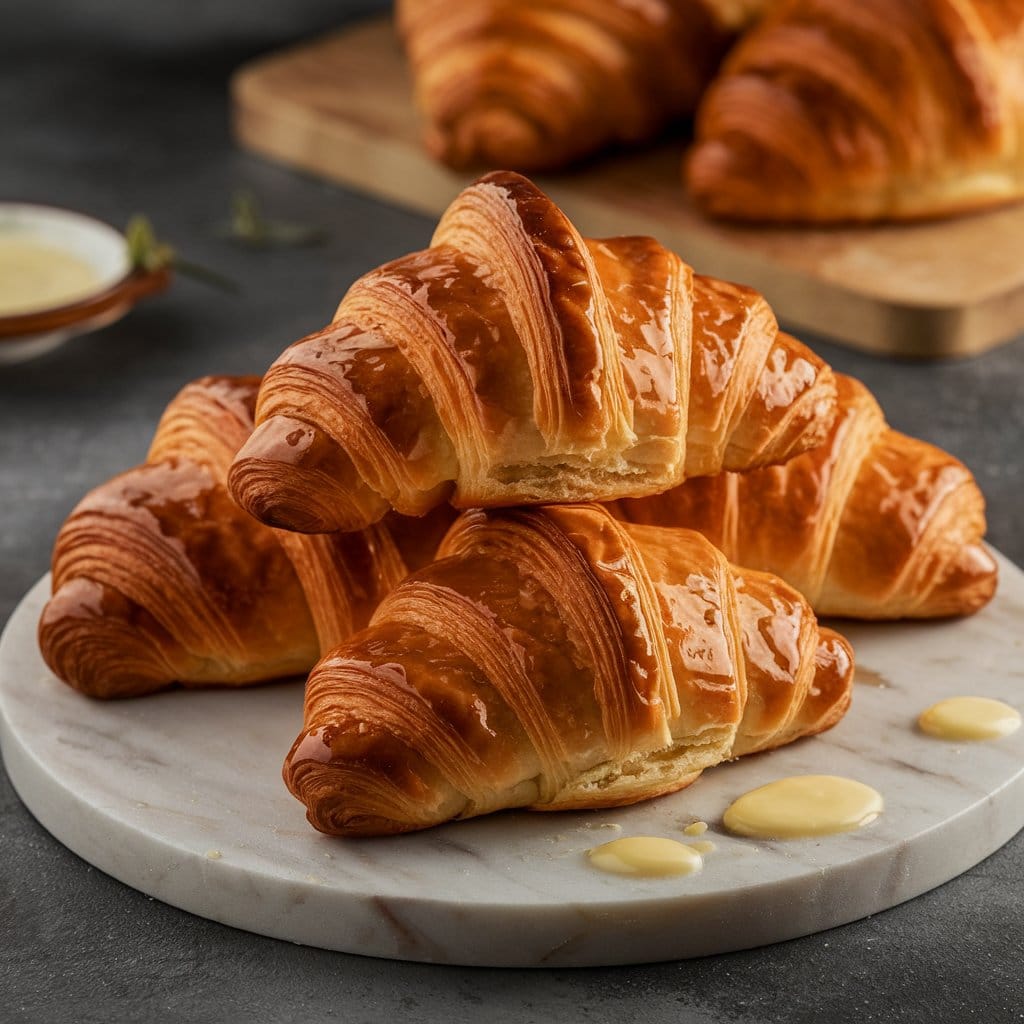
Ingredients:
- Flour: 4 cups
- Sugar: 1/4 cup
- Salt: 2 teaspoons
- Yeast: 2 1/4 teaspoons
- Butter (cold): 1 cup (for dough) + 1/2 cup (for laminating)
- Milk: 1 cup, warm
- Egg: 1 (for egg wash)
Nutrition Facts (Per Croissant):
| Nutrient | Amount |
|---|---|
| Calories | 250 |
| Protein | 6g |
| Fat | 12g |
| Carbs | 30g |
Steps to Make:
- Prepare the Dough:
- Combine 4 cups all-purpose flour, 1/4 cup sugar, 2 tsp salt, and 2 1/4 tsp yeast in a large bowl. Mix well.
- Gradually add 1 cup warm milk (around 110°F/45°C). Stir until a sticky dough forms.
- Knead on a floured surface for 8-10 minutes until smooth and elastic.
- Shape the dough into a ball and place it in a greased bowl. Cover with a damp cloth and let it rest for 1 hour until it doubles in size.
- Laminate the Dough:
- Roll the dough into a rectangle approximately 12×18 inches.
- Flatten 1 cup cold butter into a thin block by placing it between parchment paper and rolling it out.
- Place the butter in the center of the rolled dough and fold the edges over it, fully encasing the butter.
- Roll the dough into a larger rectangle, fold it into thirds like a letter, and chill it for 30 minutes.
- Repeat the rolling, folding, and chilling process 3-4 times to create distinct buttery layers.
- Shape the Croissants:
- Roll the laminated dough into a large, thin rectangle (about 1/8 inch thick).
- Use a sharp knife or pizza cutter to cut the dough into long triangles. The base should be about 3 inches wide, and the length should be 8-9 inches.
- Starting at the base of each triangle, roll the dough tightly toward the tip, stretching slightly as you roll. Curve the ends to form the classic crescent shape.
- Proofing:
- Arrange the croissants on a parchment-lined baking sheet, leaving enough space between each.
- Cover loosely with plastic wrap or a damp cloth and let them rise in a warm spot (around 75°F/24°C) for 1-2 hours. The croissants should puff up and feel airy when lightly pressed.
- Bake:
- Preheat the oven to 375°F (190°C).
- In a small bowl, whisk 1 egg with 1 tbsp water to create an egg wash. Brush the croissants evenly for a golden finish.
- Bake for 15-20 minutes or until golden brown and flaky. Rotate the baking sheet halfway through for even baking.
- Let the croissants cool slightly before serving.
Enjoy your buttery, flaky croissants with a side of jam, honey, or coffee for the perfect breakfast treat!
Delicious Breakfast Pastry Recipes
1. Danish Pastry with Cream Cheese and Berries
2. Apple Turnovers
3. Savory Spinach and Feta Pastries
4. Cinnamon Rolls
5. Pain au Chocolat
6. Blueberry Streusel Muffins
Breakfast pastries are a delightful way to start your day, and they pair perfectly with other morning favorites like coffee or tea. If you’re looking for variety, consider exploring easy chicken breakfast recipes to add a savory twist to your meal. For those who prefer something unique, you might enjoy a hearty breakfast burrito, packed with flavors that complement the buttery flakiness of croissants. If you’re watching your diet, why not try a recipe for healthy and tasty breakfast pizza? These options not only elevate your breakfast table but also show how versatile pastries can be when combined with other creative dishes.
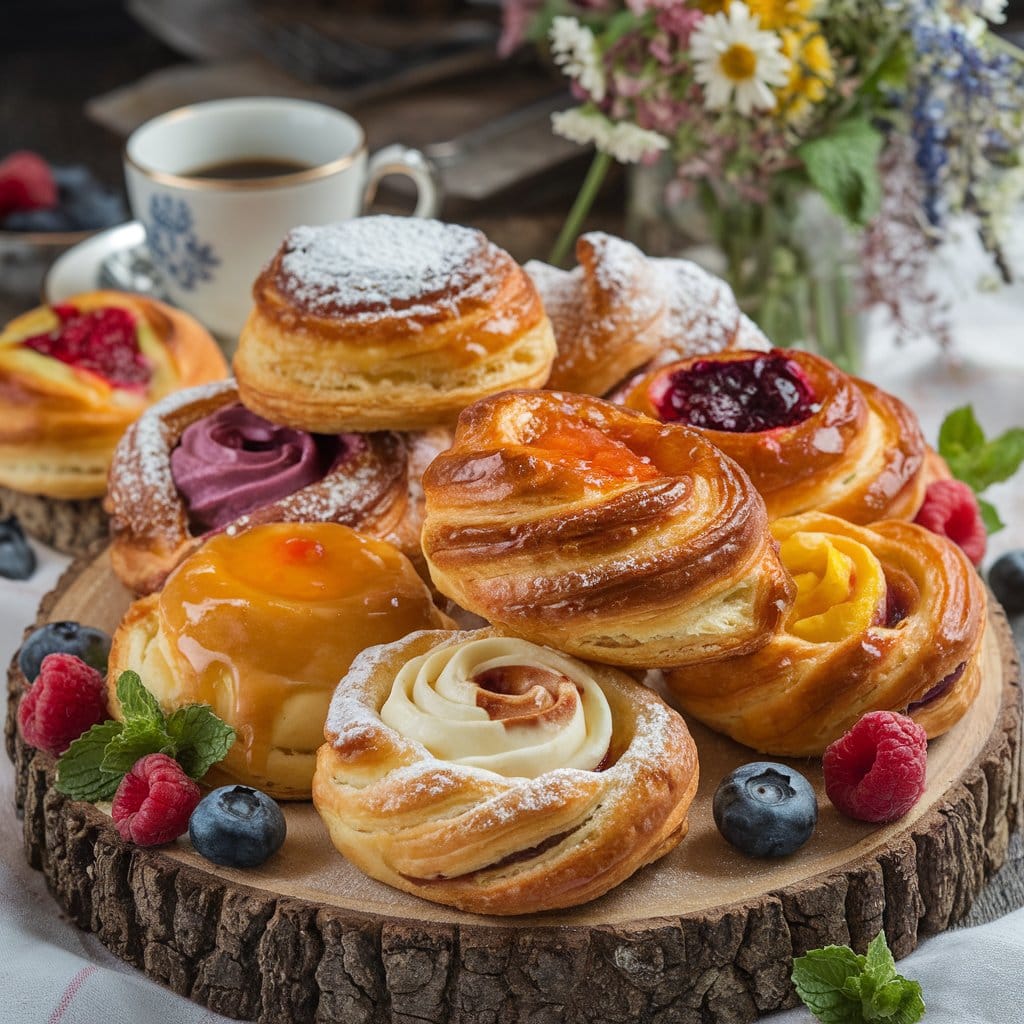
Popular Breakfast Pastries Around the World
Every culture has its twist on breakfast pastries. Let’s travel through taste buds, shall we?
- Europe: Think pain au chocolat, strudel, and buttery brioche.
- Asia: Ever tried a custard-filled bun or mooncakes? They’re subtle yet satisfying.
- America: Cinnamon rolls and pecan twists rule breakfast tables here.
Each pastry tells a story of its origin, culture, and love for good food.
Common Problems When Baking Breakfast Pastries
Let’s face it—baking pastries can feel like rocket science. But don’t worry, here’s how to solve the most common issues:
- Dough Not Rising: Your yeast might be old, or the water was too hot or cold.
- Burnt Tops, Raw Insides: Check your oven temperature with an external thermometer.
- Lack of Flakiness: Ensure your butter stays cold when working with the dough.
Quick Fix: If your pastry isn’t perfect, call it “rustic” and enjoy it anyway.
Breakfast Pastries for Special Diets
Craving pastries but have dietary restrictions? Don’t worry! Here are some options:
- Gluten-Free: Use almond or coconut flour.
- Vegan: Replace butter with coconut oil and eggs with flaxseed or chia seed slurry.
- Low-Sugar: Swap regular sugar with monk fruit or stevia.
Pairing Breakfast Pastries with Beverages
Breakfast pastries shine even brighter when paired with the right drink. Imagine biting into a warm, buttery croissant while sipping on a hot cappuccino—heaven, right? Here are some classic pairings:
- Coffee and Croissants: The rich, bitter notes of coffee balance the buttery goodness of croissants.
- Tea and Scones: A cup of Earl Grey complements the crumbly texture of scones.
- Juices and Muffins: Fresh orange juice with a sweet blueberry muffin? Yes, please!
Fun Fact: In France, pairing pain au chocolat with a café au lait is practically a national pastime. 🇫🇷
Popular Breakfast Pastries Around the World
The variety of breakfast pastries worldwide is a testament to human creativity. Let’s explore more regional favorites:
- Italy: Cornetti, a less buttery cousin of the croissant, often filled with jam or Nutella.
- Germany: Pretzels! These savory pastries pair wonderfully with mustard or cheese.
- Middle East: Manakish, a flatbread often topped with za’atar or cheese, is a savory twist on the concept of breakfast pastries.
Cultural Tip: When in doubt, ask a local baker what their specialty is. You’ll discover hidden gems that don’t make it to tourist guides.
The Future of Breakfast Pastries
As we move toward a more health-conscious and eco-friendly world, breakfast pastries are evolving. Here are some trends to watch:
- Healthier Pastries: Bakers are experimenting with low-carb flours, natural sweeteners, and nutrient-dense fillings like nuts and seeds.
- Plant-Based Options: Vegan croissants and danishes are becoming mainstream, ensuring everyone can enjoy these treats.
- Sustainable Baking: Using local ingredients and reducing food waste are hot topics in pastry kitchens.
FAQ About Breakfast Pastries
1. What are breakfast pastries?
Breakfast pastries are sweet or savory baked goods typically enjoyed in the morning. Popular examples include croissants, danishes, muffins, scones, and turnovers. These treats are often made with ingredients like flour, butter, sugar, and eggs, and can be flavored with fruits, nuts, chocolate, or spices.
2. Are breakfast pastries healthy?
It depends on the pastry and its ingredients. While traditional pastries are rich in butter and sugar, there are healthier options available, such as those made with whole grains, natural sweeteners, or plant-based ingredients. Moderation is key when enjoying pastries as part of a balanced diet.
3. Can I make breakfast pastries at home?
Absolutely! Many breakfast pastries can be made at home with simple ingredients. Recipes like muffins, scones, and turnovers are beginner-friendly, while croissants and danishes may require more time and technique. Homemade pastries allow you to control the ingredients for healthier or customized versions.
4. What is the best way to store breakfast pastries?
- Fresh Pastries: Store at room temperature in an airtight container for 1-2 days.
- Freezing: Most pastries can be frozen for up to 3 months. Wrap them tightly in plastic wrap and place them in a freezer bag.
- Reheating: Warm in the oven or microwave to restore freshness.
5. What drinks pair well with breakfast pastries?
- Coffee: Complements buttery croissants and rich muffins.
- Tea: Works well with scones or delicate pastries like danishes.
- Juice: Pairs nicely with fruity pastries such as blueberry muffins or apple turnovers.
6. Are there vegan or gluten-free breakfast pastries?
Yes! Vegan pastries are made without dairy or eggs, using alternatives like almond milk, coconut oil, and flaxseed. Gluten-free pastries use flours like almond, coconut, or oat flour. Many recipes are available to suit specific dietary needs.
Conclusion: Why Breakfast Pastries Remain an All-Time Favorite
Breakfast pastries aren’t just food; they’re a universal love language. Whether it’s a quick grab-and-go muffin or a leisurely morning with a warm danish, these treats bring comfort and joy to our mornings.
So, why not try making your own? You might discover a hidden talent—or at the very least, you’ll have some delicious results to show for your effort. Remember, even if it doesn’t look bakery-perfect, it’s made with love—and that’s what matters most.
